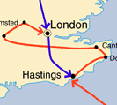![]() The Conquest of England
The Conquest of England
![The Tower of London [Photo: Patrick Ottaway]](images/tower.jpg) After
his victory at Hastings William had to reach London to secure his crown, but
first he secured Dover and the other Channel ports in Kent. William then
passed through Canterbury and crossed the Thames at Wallingford to the west of
London where Stigand, the Archbishop of Canterbury, submitted to him.
After
his victory at Hastings William had to reach London to secure his crown, but
first he secured Dover and the other Channel ports in Kent. William then
passed through Canterbury and crossed the Thames at Wallingford to the west of
London where Stigand, the Archbishop of Canterbury, submitted to him.
 From Wallingford William moved on to
Berkhampstead where a group of London citizens agreed to admit him to the
city. William was crowned king in Westminster on Christmas Day 1066. He then
built two castles in London, one of which would have a keep known as the White
Tower (begun 1078). The construction of castles and the fortification of towns
was the key to the successful conquest of England. The risk of rebellion
against the King was minimised by the replacement of the Anglo-Saxon
aristocracy by Williamís own men.
From Wallingford William moved on to
Berkhampstead where a group of London citizens agreed to admit him to the
city. William was crowned king in Westminster on Christmas Day 1066. He then
built two castles in London, one of which would have a keep known as the White
Tower (begun 1078). The construction of castles and the fortification of towns
was the key to the successful conquest of England. The risk of rebellion
against the King was minimised by the replacement of the Anglo-Saxon
aristocracy by Williamís own men.
![Norman gateway (blocked) of Rougemont castle gateway, Exeter [Photo: Patrick Ottaway]](images/exet.jpg) William
did encounter some opposition, first of all in the west country which was
crushed with the capture of Exeter in 1068. William also defeated rebels in
York in 1068 and built a castle in the city. Early in 1069 he built a second
castle at York,
William
did encounter some opposition, first of all in the west country which was
crushed with the capture of Exeter in 1068. William also defeated rebels in
York in 1068 and built a castle in the city. Early in 1069 he built a second
castle at York, ![York castle: excavations in the bailey with the Norman motte and 13th century keep behind [York Archaeological Trust]](images/castlegar.jpg) but in September the city was the centre of a second and more
serious revolt supported by a large Danish army arriving in 240 ships. This
was put down with great force and brutality.
but in September the city was the centre of a second and more
serious revolt supported by a large Danish army arriving in 240 ships. This
was put down with great force and brutality.
Unrest in the north provided an opportunity for King Malcolm Canmore of Scotland to raid England as far south as the River Tees, but faced with a Norman army he was forced to come to terms with William in 1072. The last serious, and unsuccessful, rebellion in England took place in 1070 when Morcar, one of the Anglo-Saxon earls, joined a warrior known as Hereward the Wake whose base was in the Isle of Ely near Peterborough.